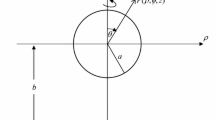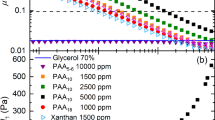Summary
The theory of polar fluids, briefly reviewed and shown to be identical to the theory of micropolar fluids, is applied to five different viscometric flows and to the flow around a slowly rotating sphere. Comparing theoretical predictions with experimental results for the viscometric flows it is demonstrated that the theory may serve as a model for the flow of suspensions if a velocity slip along a solid wall is accounted for.
In the important limit, in which the length scale of the microstructure is much less than a characteristic geometric length theNavier-Stokes equations subject to a velocity slip boundary condition are all one has to work with for the evaluation of the apparent fluidity; a positive slip coefficient guarantees the “sigma” phenomenon to result. For other flows one may also adopt this procedure as long as one is interested only in average macroscopic quantities. In this way it turns out that the classical expressions for the hydrodynamic force and torque on a slowly translating and rotating sphere may be employed if the geometric radius is replaced by an apparent one.
But even for the evaluation of local quantities, where the full system of equations has to be used, one needs a velocity slip boundary condition. Only then does a qualitative agreement with the experimentally determined details of the flow field result. It is demonstrated that such a requirement is a natural and physically expected supposition for any continuum approximation of a fluid with internal structures.
Zusammenfassung
Die Theorie der polaren Flüssigkeit, welche kurz referiert und für die gezeigt wird, daß sie identisch ist mit der Theorie der mikropolaren Flüssigkeit, wird auf 5 stationäre Schichtenströmungen sowie auf die Strömung um eine langsam rotierende Kugel angewendet. Durch Vergleich von theoretischen Resultaten mit experimentellen Ergebnissen für Schichtenströmungen wird gezeigt, daß die Theorie durchaus als Modell für die Strömung von Suspensionen geeignet ist, vorausgesetzt, daß eine Geschwindigkeitsgleitung entlang einer Wand mitberücksichtigt wird.
In dem entscheidenden Grenzfall, in dem die Größe der Mikrostruktur klein ist im Vergleich zu charakteristischen Makrodimensionen, hat man zur Bestimmung der scheinbaren Fluidität nur dieNavier-Stokes-Gleichungen zu lösen, allerdings unter der Randbedingung einer Geschwindigkeitsgleitung; ein positiver Gleitungskoeffizient führt dann zum „Sigma“-Effekt. Auch auf andere Strömungen ist diese Methode anwendbar, solange man sich nur für irgendwelche Mittelwerte interessiert. Auf diese Weise zeigt sich, daß die klassischen Ausdrücke für die hydrodynamische Kraft und das Drehmoment auf eine sich langsam bewegende starre Kugel ihre Gültigkeit behalten, wenn man den geometrischen Radius durch einen scheinbaren ersetzt.
Aber sogar zur Berechnung lokaler Größen, für die man das vollständige Gleichungssystem benötigt, muß eine Geschwindigkeitsgleitung an der Wand angenommen werden. Denn nur dann erhält man eine qualitative Übereinstimmung mit dem experimentell bestimmten Strömungsprofil. Es wird gezeigt, daß eine derartige Annahme für jede Approximation einer Flüssigkeit mit innerer Struktur durch ein Kontinuum physikalisch zu erwarten ist.
Similar content being viewed by others
References
Dahler, J. S. J. Chem. Phys.30, 1447–1475 (1959).
Eringen, A. C. J. Math. Mech.16, 1–18 (1966).
Kline, K. A. Trans. Soc. Rheol.19, 139–145 (1975).
Lamb, H., Hydrodynamics (6th edition)(Cambridge 1932).
Ebert, F. Rheol. Acta14, 258–263 (1975).
Goldsmith, H. L. andS. G. Mason, Rheology, Vol. 4 (New York 1967).
Karnis, A., H. L. Goldsmith andS. G. Mason J. Colloid Interphase Sci.22, 531–553 (1966).
Bhatnagar, K. S. andR. Rajagopalan Rheol. Acta7, 209–217 (1968).
Cowin, S. C. Adv. Appl. Mech.14, 279–347 (1974).
Irving, J. M. andJ. G. Kirkwood J. Chem. Phys.18, 817–829 (1950).
Dahler, J. S., Research Frontiers in Fluid Dynamics (New York 1965).
Condiff, D. W. andJ. S. Dahler Phys. Fluids7, 842–854 (1964).
Aero, E. L., A. N. Bulygin andE. V. Kuvshinskii Prikl. Mat. Mekh.29, 297–308; translated in J. Appl. Math. Mech.29, 333–346 (1965).
Cowin, S. C. Phys. Fluids11, 1919–1927 (1968).
Ravindran, R. andR. G. Devi Rheol. Acta11, 99–105 (1972).
Cercignani, C., Mathematical Methods in Kinetic Theory (1969).
Kemblowski, Z. Zeszyty naukowe Politechniki Lodzkiej123, 5–85 (1969).
Schofield, R. K. andG. W. Scott Blair J. Phys. Chem.34, 248–262 (1930).
Vand, V. J. Phys. Chem.52, 277–314 (1948).
Coope, J. A. R., R. F. Snider andF. R. McCourt J. Chem. Phys.43, 2269–2275 (1965).
Author information
Authors and Affiliations
Additional information
With 2 figures
Rights and permissions
About this article
Cite this article
Brunn, P. The velocity slip of polar fluids. Rheol Acta 14, 1039–1054 (1975). https://doi.org/10.1007/BF01515899
Received:
Issue Date:
DOI: https://doi.org/10.1007/BF01515899




